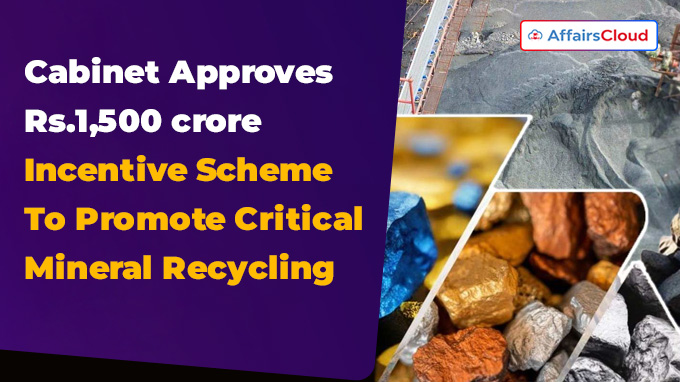 In September 2025, the Union Cabinet chaired by Prime Minister (PM) Narendra Modi, has approved Rs 1,500 crore incentive scheme, designed to promote recycling capacity for extracting and producing critical minerals from secondary sources.
In September 2025, the Union Cabinet chaired by Prime Minister (PM) Narendra Modi, has approved Rs 1,500 crore incentive scheme, designed to promote recycling capacity for extracting and producing critical minerals from secondary sources.
- This newly approved scheme, managed by the Ministry of Mines (MoM) under the National Critical Mineral Mission (NCMM), aims to strengthen India’s domestic capacity and enhance supply chain resilience.
Exam Hints:
- What? Approval of new incentive scheme
- Approved by: Union Cabinet, chaired by PM Narendra Modi
- Total Outlay: Rs 1,500 Crore
- Ministry: Ministry of Mines (MoM)
- Mission: National Critical Mineral Mission (NCMM)
- Purpose: To Promote Critical Mineral Recycling
- Time Period: 6 Years (from FY26 to FY31)
- Incentive Structure: Capex Subsidy (20%) and Opex Subsidy (40% in 2nd year and 60% in 5th year)
Key Details of incentive scheme:
Tenure: This new incentive scheme will span over a period of 6 years from Financial Year 2025-26 (FY26) to FY31.
Eligible Livestock: The eligible livestock feedback will cover e-waste, Lithium-ion Battery (LIB) scrap, and other categories such as catalytic converters from end-of-life vehicles.
Beneficiaries: Both established recyclers and new entrants, including start-ups, will be eligible entities to avail the benefits of the scheme.
- Also, 1/3rd (33.33%) of total budget outlay of the scheme are reserved for smaller entities.
Capacity: The scheme aims to establish a minimum 270 kilo ton(Kt) of annual recycling capacity, which will further result in about 40 Kt of critical mineral production.
Investment: It is also projected to attract investment worth nearly Rs 8,000 crore and generate around 70,000 direct and indirect jobs.
Incentive Structure:
The scheme provides two forms of incentives i.e. Capital Expenditure (Capex) subsidy and Operational Expenditure (Opex) subsidy.
Capex Subsidy: Under this, 20% capital subsidy will be provided on plant machinery, equipment, and associated utilities for units starting production within the specified time period.
- Subsidy benefits will be lower in case of delays in meeting deadlines.
Opex Subsidy: This subsidy will be linked to incremental sales over the base year (FY26) and disbursed in two phases, 40% in the 2nd year and the remaining 60% in the 5th year, subject to achieving sales thresholds.
Incentive Ceiling:
- Large units: Up to Rs.50 crore (Opex capped at Rs.10 crore).
- Small units: Up to Rs.25 crore (Opex capped at Rs.5 crore).
About National Critical Minerals Mission (NCMM):
Background: In January 2025, the Union Cabinet has approved the NCMM with an allocation of Rs 16,300 crore, envisaging a total outlay of Rs 34, 300 crore for a period of 7 years.
Aim: To boost domestic production, reduce reliance on imports, and promote exploration and responsible sourcing of critical minerals.
Key Task: Under NCMM, the Geographical Survey of India (GSI) has been entrusted with the responsibility to conduct 1,200 exploration projects from 2024-25 to 2030-31.
Recent Related News:
In June 2025, the Cabinet Committee on Economic Affairs (CCEA) chaired by PM Narendra Modi, has approved the Revised Jharia Master Plan (JMP) worth Rs 5,940.97 crore, to deal with issues related to fire, land subsidence, and the rehabilitation of affected families in the Jharia Coalfield in Jharia, Dhanbad, Jharkhand.




